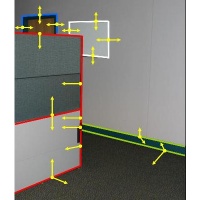
Layers are one of the most well studied ways of representing a 3D scene. Although man-made scenes often contain constant intensity planar regions (textureless layers), it is almost always assumed that there is enough texture in each layer to compute the motion of the layer using image alignment and to base layer assignment on pixel-wise differencing. Since (the interior of) any textureless region is consistent with the motion of any layer, most existing algorithms assign constant intensity regions to the dominant layer, or to a random nearby layer. The one source of information that can be used to resolve the inherent ambiguity, namely the lines separating the constant intensity regions, is instead often treated as an outlier. In this project we have studied the question of what can and cannot be computed in a 3D world consisting of a set of constant intensity planar regions (textureless layers). We have derived an algorithm to determine when the shape of the scene is unique, when it is inherently ambiguous, and if so, what the set of possible scene shapes is. See our example results described in the papers below.
